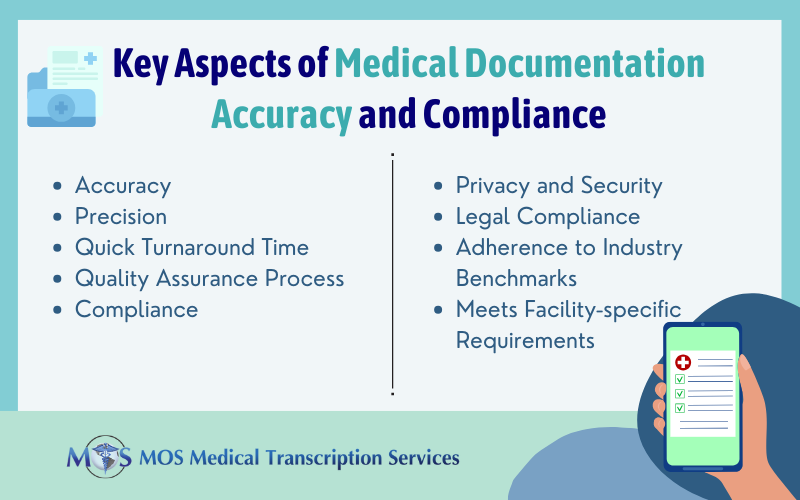
Table of Contents
Medical transcriptionists are responsible for producing various types of patient care reports, such as histories and physical examinations, progress reports, emergency room notes, consultations, operative reports, discharge summaries, clinic notes, referral letters, radiology and pathology reports. Accuracy and compliance are crucial aspects of medical documentation. Companies providing medical transcription services have stringent quality assurance (QA) processes in place to guarantee that the transcribed reports are 99 percent accurate or better, are an exact account of the original dictation, and comply with legal and regulatory requirements.
Understanding Quality and Compliance in Medical Transcription
- Quality Aspects
Accuracy and attention to detail are paramount in medical transcription. Transcriptionists must ensure precision and meticulousness in capturing medical information. Errors or omissions can have significant implications for patient care, highlighting the critical nature of the transcriptionist’s role.
The American Society for Testing and Materials (ASTM) provides standards related to healthcare documentation and information exchange, which can indirectly impact medical transcription practices. An article published by Elite Learning reported that the task group on processes in ASTM’s E31.22 subcommittee on Health Information Transcription and Documentation determined that quality documentation is dependent on four distinct processes:
- Dictation
- Transcription
- Management, and
- Quality assurance
This document also outlines the specific roles and responsibilities of various personnel, including authors, transcriptionists, managers, and quality reviewers, who collectively contribute to the production of high-quality healthcare documentation. On the matter of error types and accuracy percentages involved in a QA program for medical transcription, the guide states that the management of a transcription department should work with transcriptionists to set up standards for:
- Errors, omissions and inconsistencies
- Turnaround time
- Formats, style and editing
- Frequency and volume of work to be reviewed, and
- Productivity requirements
Ensuring transcription accuracy involves 3 main elements: precision, proofreading and editing, and quality assurance.
- Compliance
U.S. medical transcription service providers must prioritize protection of sensitive patient data. This implies adhering to laws and regulations, such as the Health Insurance Portability and Accountability Act (HIPAA). Adherence to HIPAA regulations ensures that sensitive electronic protected health information (ePHI) is handled securely during transcription, preventing unauthorized access, disclosure, or breaches.

Compliance in medical documentation implies fulfilling the following aspects:
- Privacy and security: Medical transcriptionists must adhere to laws and regulations, such as the Health Insurance Portability and Accountability Act (HIPAA) in the United States. They should maintain patient confidentiality, protect sensitive information, and follow secure transmission and storage protocols.
- Legal requirements: Transcribed documents should meet legal standards and requirements. This includes accurate documentation of patient information, healthcare provider details, and any necessary signatures or authorizations.
- Industry standards: Medical transcriptionists should be familiar with industry standards and guidelines, such as those set forth by the Association for Healthcare Documentation Integrity (AHDI). These standards help ensure compliance, consistency, accuracy, and professionalism in medical documentation practices.
- Facility-specific requirements: Transcriptionists must also familiarize themselves with the style guides and preferred formatting guidelines of different healthcare organizations. It is essential for them to consistently adhere to these guidelines to ensure that the transcribed documents maintain uniformity and clarity. By following the specific style guides, transcriptionists contribute to producing documents that align with the organization’s standards and facilitate effective communication within the healthcare industry.
Key Components of QA in Medical Transcription
Quality assurance is a vital and meticulous step in the medical transcription process. It involves conducting rigorous checks on transcribed documents to ensure they meet high standards of accuracy, consistency, and regulatory compliance. These checks may involve comparing the transcribed text with the original audio recordings or reviewing the documents against industry-specific guidelines. Here are the important components of a QA program:
The process begins with transcription, where medical transcriptionists listen to audio recordings and accurately transcribe the spoken words, medical terminology, and pertinent information. Following transcription, thorough editing and proofreading are conducted to eliminate errors in grammar, spelling, and formatting, ensuring the final document is error-free and meets quality standards.
The QA team in a medical transcription company has an excellent eye for detail and is adept in all aspects of the transcription process. Team members are knowledgeable about body systems and diseases, and can detect errors in
- Medical abbreviations, foreign terms, jargon, word differentiation, slang and plurals in medical language
- Roots, prefixes, suffixes and combinations associated with medical word building
- Spelling, grammar, punctuation and style
- Layout of medical reports
- Organization-specific documentation requirements
QA is a multi-layered process:
- The first level is the medical transcription process. This involves listening to the audio recordings of healthcare professionals and converting them into written documents. Transcriptionists take care to accurately type out the spoken words, medical terminologies, and other relevant information.
- At the second level, the files are checked by a proofreader (PR). The proofreader examines the working document for integrity of content. The transcripts are thoroughly reviewed to ensure that dictated medical information is accurately captured, including diagnoses, treatments, medications, and lab results. Medical terminology, abbreviations, and procedures are checked. Grammatical mistakes, misspellings, and inconsistencies are identified and corrected. The documentation is also assessed to ensure it adheres to specific formatting and style guidelines, including standardized medical abbreviations and organization-specific preferences, to maintain consistency and clarity. Familiarity with style guides and formatting preferences of healthcare organizations is essential for ensuring uniformity.
- At the third level, files are checked by a quality controller (QC). The QC checks the overall quality of the transcripts before they are delivered.
Quality assurance plays a critical role in the transcription by upholding standards of accuracy, consistency, compliance, and attention to detail. In a medical transcription company, ensuring quality and compliance in documentation is a team effort. Their professional staff stay updated with industry standards to help ensure the quality and compliance of transcribed documents, supporting effective healthcare communication and delivery.


